SPSS Analysis of Leukemia Treatment Intervention Study Results
VerifiedAdded on 2023/04/22
|21
|4437
|427
Report
AI Summary
This report analyzes the effectiveness of different leukemia treatment procedures using SPSS, focusing on an intervention group receiving a new therapy compared to a control group receiving regular care. The study, conducted over six weeks, uses both quantitative and qualitative methods to assess various factors, including test scores, self-image index, and the occurrence of relapses. Statistical tools such as Independent sample t-tests, Mann Whitney U test, One-way ANOVA, and partial correlation are applied to evaluate the data collected from 45 participants. Qualitative data from interviews is analyzed thematically to provide insights into participants' perceptions of the treatments. The results indicate significant differences in treatment effectiveness between the intervention and control groups, with varying impacts on relapse occurrence and self-image, thereby contributing to a comprehensive understanding of leukemia treatment outcomes. Desklib provides access to similar past papers and solved assignments for students.
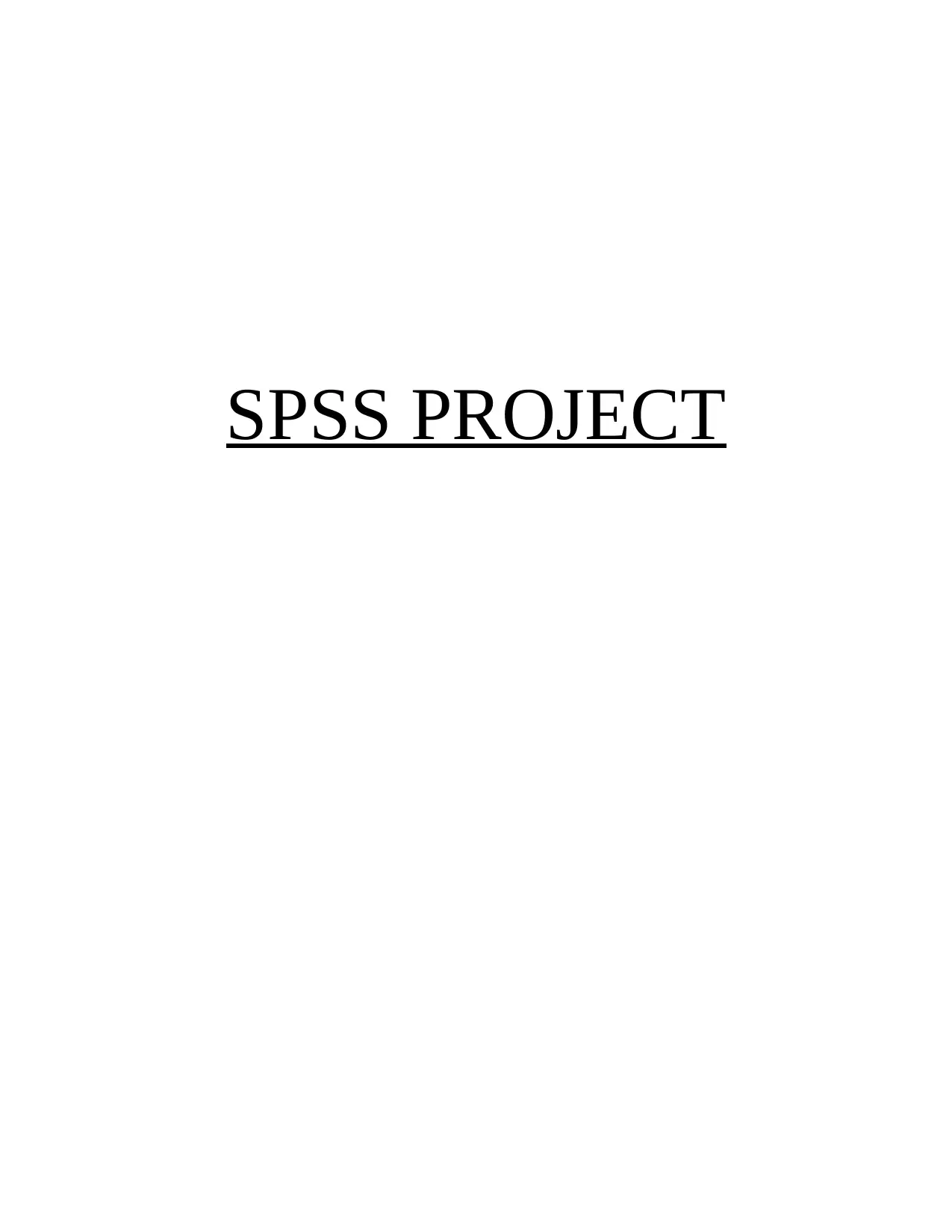
SPSS PROJECT
Paraphrase This Document
Need a fresh take? Get an instant paraphrase of this document with our AI Paraphraser
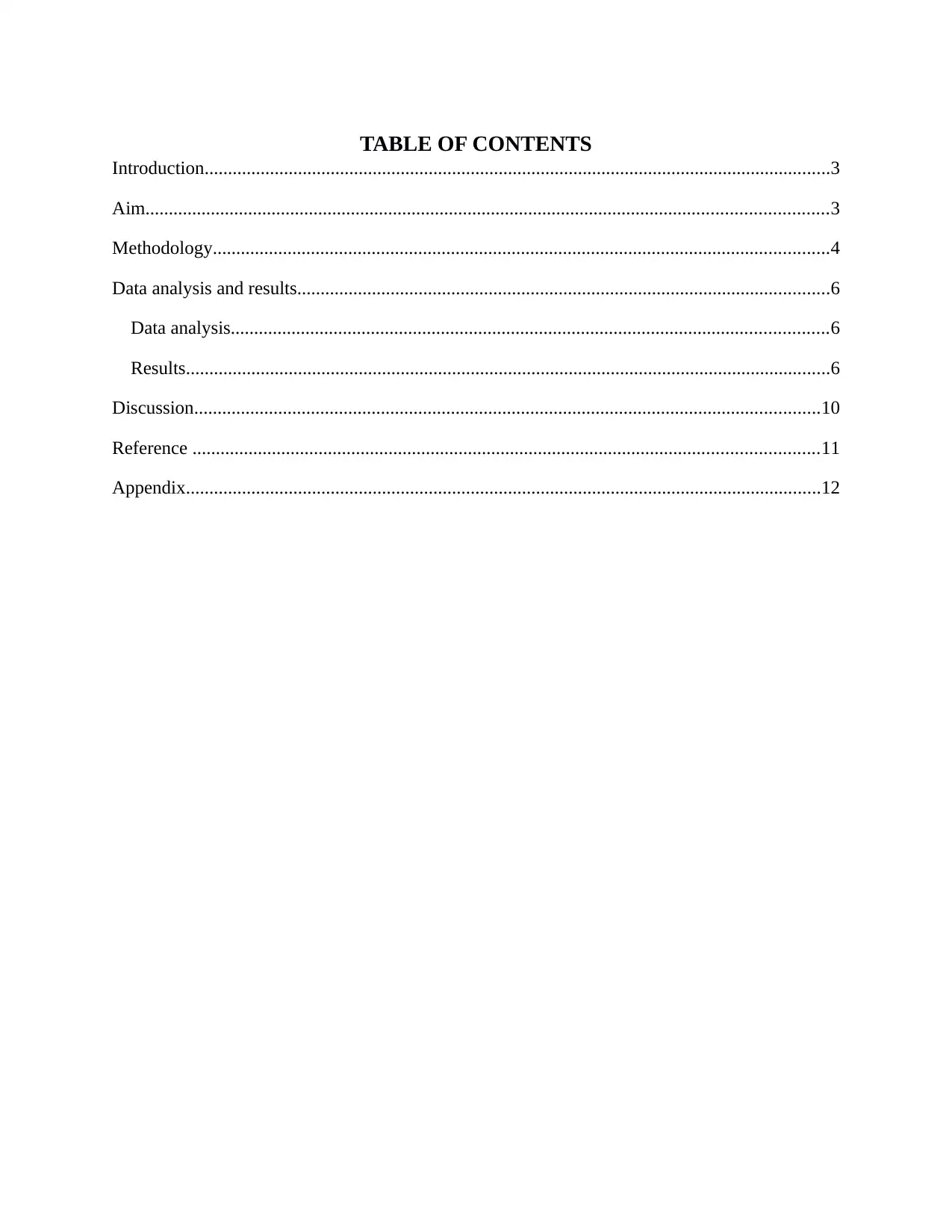
TABLE OF CONTENTS
Introduction......................................................................................................................................3
Aim..................................................................................................................................................3
Methodology....................................................................................................................................4
Data analysis and results..................................................................................................................6
Data analysis................................................................................................................................6
Results..........................................................................................................................................6
Discussion......................................................................................................................................10
Reference ......................................................................................................................................11
Appendix........................................................................................................................................12
Introduction......................................................................................................................................3
Aim..................................................................................................................................................3
Methodology....................................................................................................................................4
Data analysis and results..................................................................................................................6
Data analysis................................................................................................................................6
Results..........................................................................................................................................6
Discussion......................................................................................................................................10
Reference ......................................................................................................................................11
Appendix........................................................................................................................................12
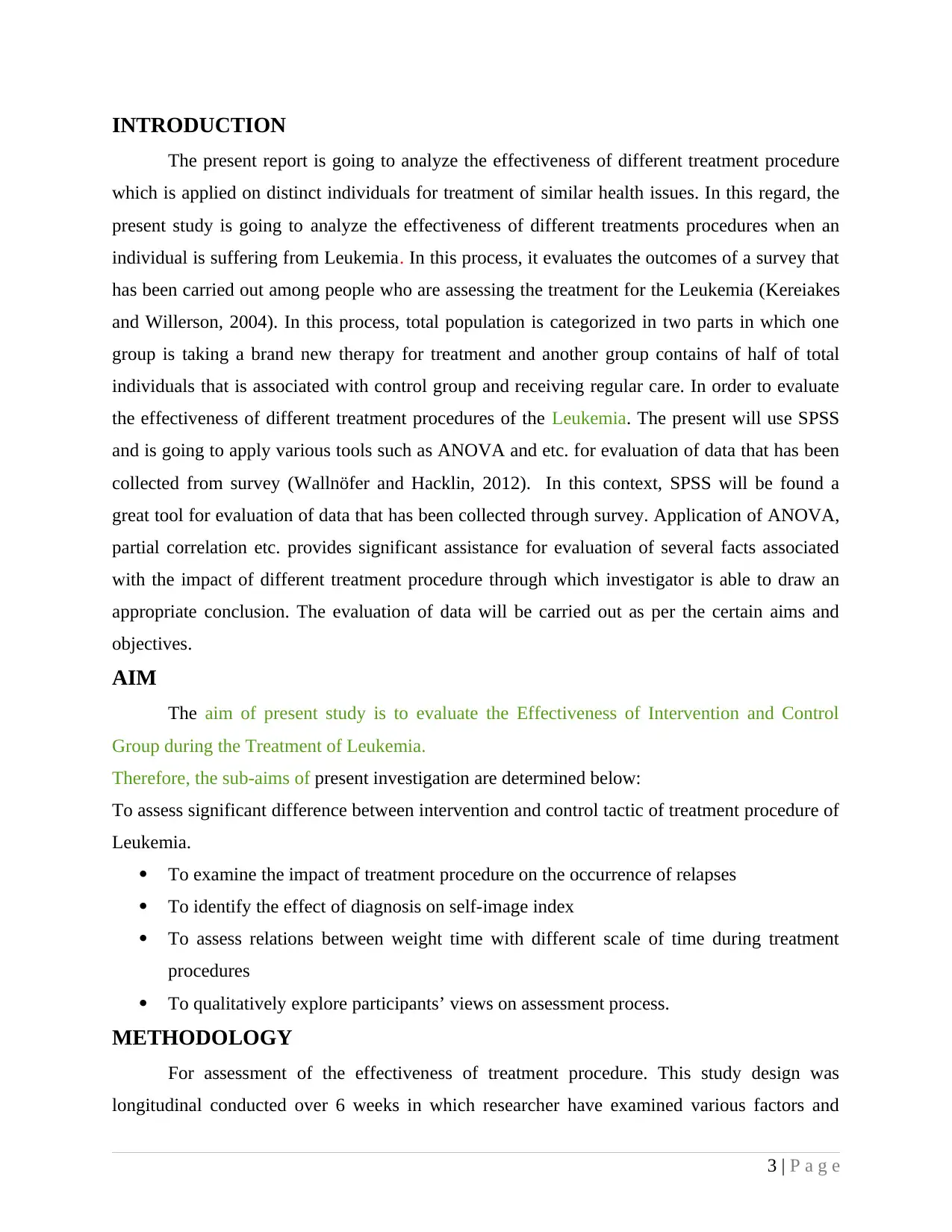
INTRODUCTION
The present report is going to analyze the effectiveness of different treatment procedure
which is applied on distinct individuals for treatment of similar health issues. In this regard, the
present study is going to analyze the effectiveness of different treatments procedures when an
individual is suffering from Leukemia. In this process, it evaluates the outcomes of a survey that
has been carried out among people who are assessing the treatment for the Leukemia (Kereiakes
and Willerson, 2004). In this process, total population is categorized in two parts in which one
group is taking a brand new therapy for treatment and another group contains of half of total
individuals that is associated with control group and receiving regular care. In order to evaluate
the effectiveness of different treatment procedures of the Leukemia. The present will use SPSS
and is going to apply various tools such as ANOVA and etc. for evaluation of data that has been
collected from survey (Wallnöfer and Hacklin, 2012). In this context, SPSS will be found a
great tool for evaluation of data that has been collected through survey. Application of ANOVA,
partial correlation etc. provides significant assistance for evaluation of several facts associated
with the impact of different treatment procedure through which investigator is able to draw an
appropriate conclusion. The evaluation of data will be carried out as per the certain aims and
objectives.
AIM
The aim of present study is to evaluate the Effectiveness of Intervention and Control
Group during the Treatment of Leukemia.
Therefore, the sub-aims of present investigation are determined below:
To assess significant difference between intervention and control tactic of treatment procedure of
Leukemia.
To examine the impact of treatment procedure on the occurrence of relapses
To identify the effect of diagnosis on self-image index
To assess relations between weight time with different scale of time during treatment
procedures
To qualitatively explore participants’ views on assessment process.
METHODOLOGY
For assessment of the effectiveness of treatment procedure. This study design was
longitudinal conducted over 6 weeks in which researcher have examined various factors and
3 | P a g e
The present report is going to analyze the effectiveness of different treatment procedure
which is applied on distinct individuals for treatment of similar health issues. In this regard, the
present study is going to analyze the effectiveness of different treatments procedures when an
individual is suffering from Leukemia. In this process, it evaluates the outcomes of a survey that
has been carried out among people who are assessing the treatment for the Leukemia (Kereiakes
and Willerson, 2004). In this process, total population is categorized in two parts in which one
group is taking a brand new therapy for treatment and another group contains of half of total
individuals that is associated with control group and receiving regular care. In order to evaluate
the effectiveness of different treatment procedures of the Leukemia. The present will use SPSS
and is going to apply various tools such as ANOVA and etc. for evaluation of data that has been
collected from survey (Wallnöfer and Hacklin, 2012). In this context, SPSS will be found a
great tool for evaluation of data that has been collected through survey. Application of ANOVA,
partial correlation etc. provides significant assistance for evaluation of several facts associated
with the impact of different treatment procedure through which investigator is able to draw an
appropriate conclusion. The evaluation of data will be carried out as per the certain aims and
objectives.
AIM
The aim of present study is to evaluate the Effectiveness of Intervention and Control
Group during the Treatment of Leukemia.
Therefore, the sub-aims of present investigation are determined below:
To assess significant difference between intervention and control tactic of treatment procedure of
Leukemia.
To examine the impact of treatment procedure on the occurrence of relapses
To identify the effect of diagnosis on self-image index
To assess relations between weight time with different scale of time during treatment
procedures
To qualitatively explore participants’ views on assessment process.
METHODOLOGY
For assessment of the effectiveness of treatment procedure. This study design was
longitudinal conducted over 6 weeks in which researcher have examined various factors and
3 | P a g e
⊘ This is a preview!⊘
Do you want full access?
Subscribe today to unlock all pages.

Trusted by 1+ million students worldwide
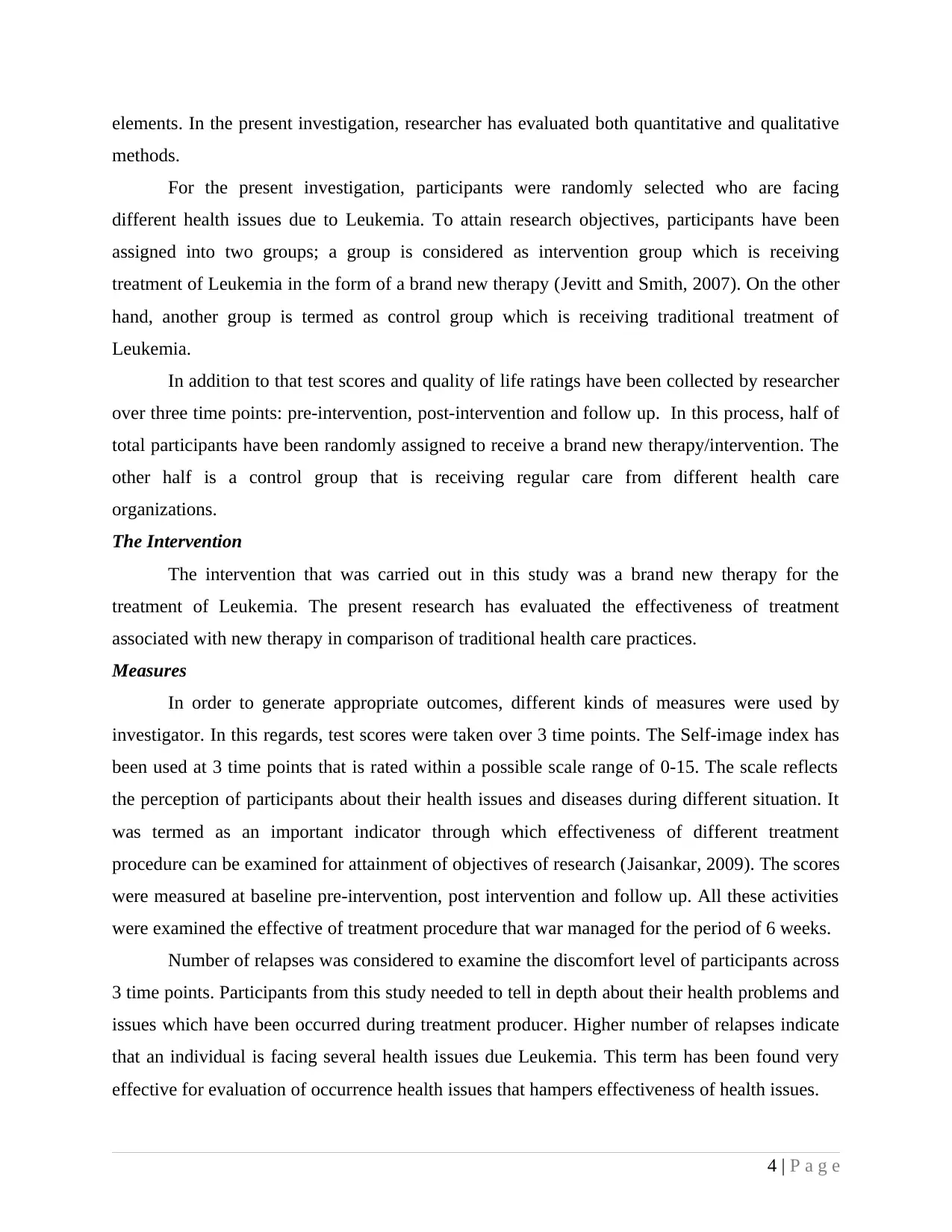
elements. In the present investigation, researcher has evaluated both quantitative and qualitative
methods.
For the present investigation, participants were randomly selected who are facing
different health issues due to Leukemia. To attain research objectives, participants have been
assigned into two groups; a group is considered as intervention group which is receiving
treatment of Leukemia in the form of a brand new therapy (Jevitt and Smith, 2007). On the other
hand, another group is termed as control group which is receiving traditional treatment of
Leukemia.
In addition to that test scores and quality of life ratings have been collected by researcher
over three time points: pre-intervention, post-intervention and follow up. In this process, half of
total participants have been randomly assigned to receive a brand new therapy/intervention. The
other half is a control group that is receiving regular care from different health care
organizations.
The Intervention
The intervention that was carried out in this study was a brand new therapy for the
treatment of Leukemia. The present research has evaluated the effectiveness of treatment
associated with new therapy in comparison of traditional health care practices.
Measures
In order to generate appropriate outcomes, different kinds of measures were used by
investigator. In this regards, test scores were taken over 3 time points. The Self-image index has
been used at 3 time points that is rated within a possible scale range of 0-15. The scale reflects
the perception of participants about their health issues and diseases during different situation. It
was termed as an important indicator through which effectiveness of different treatment
procedure can be examined for attainment of objectives of research (Jaisankar, 2009). The scores
were measured at baseline pre-intervention, post intervention and follow up. All these activities
were examined the effective of treatment procedure that war managed for the period of 6 weeks.
Number of relapses was considered to examine the discomfort level of participants across
3 time points. Participants from this study needed to tell in depth about their health problems and
issues which have been occurred during treatment producer. Higher number of relapses indicate
that an individual is facing several health issues due Leukemia. This term has been found very
effective for evaluation of occurrence health issues that hampers effectiveness of health issues.
4 | P a g e
methods.
For the present investigation, participants were randomly selected who are facing
different health issues due to Leukemia. To attain research objectives, participants have been
assigned into two groups; a group is considered as intervention group which is receiving
treatment of Leukemia in the form of a brand new therapy (Jevitt and Smith, 2007). On the other
hand, another group is termed as control group which is receiving traditional treatment of
Leukemia.
In addition to that test scores and quality of life ratings have been collected by researcher
over three time points: pre-intervention, post-intervention and follow up. In this process, half of
total participants have been randomly assigned to receive a brand new therapy/intervention. The
other half is a control group that is receiving regular care from different health care
organizations.
The Intervention
The intervention that was carried out in this study was a brand new therapy for the
treatment of Leukemia. The present research has evaluated the effectiveness of treatment
associated with new therapy in comparison of traditional health care practices.
Measures
In order to generate appropriate outcomes, different kinds of measures were used by
investigator. In this regards, test scores were taken over 3 time points. The Self-image index has
been used at 3 time points that is rated within a possible scale range of 0-15. The scale reflects
the perception of participants about their health issues and diseases during different situation. It
was termed as an important indicator through which effectiveness of different treatment
procedure can be examined for attainment of objectives of research (Jaisankar, 2009). The scores
were measured at baseline pre-intervention, post intervention and follow up. All these activities
were examined the effective of treatment procedure that war managed for the period of 6 weeks.
Number of relapses was considered to examine the discomfort level of participants across
3 time points. Participants from this study needed to tell in depth about their health problems and
issues which have been occurred during treatment producer. Higher number of relapses indicate
that an individual is facing several health issues due Leukemia. This term has been found very
effective for evaluation of occurrence health issues that hampers effectiveness of health issues.
4 | P a g e
Paraphrase This Document
Need a fresh take? Get an instant paraphrase of this document with our AI Paraphraser
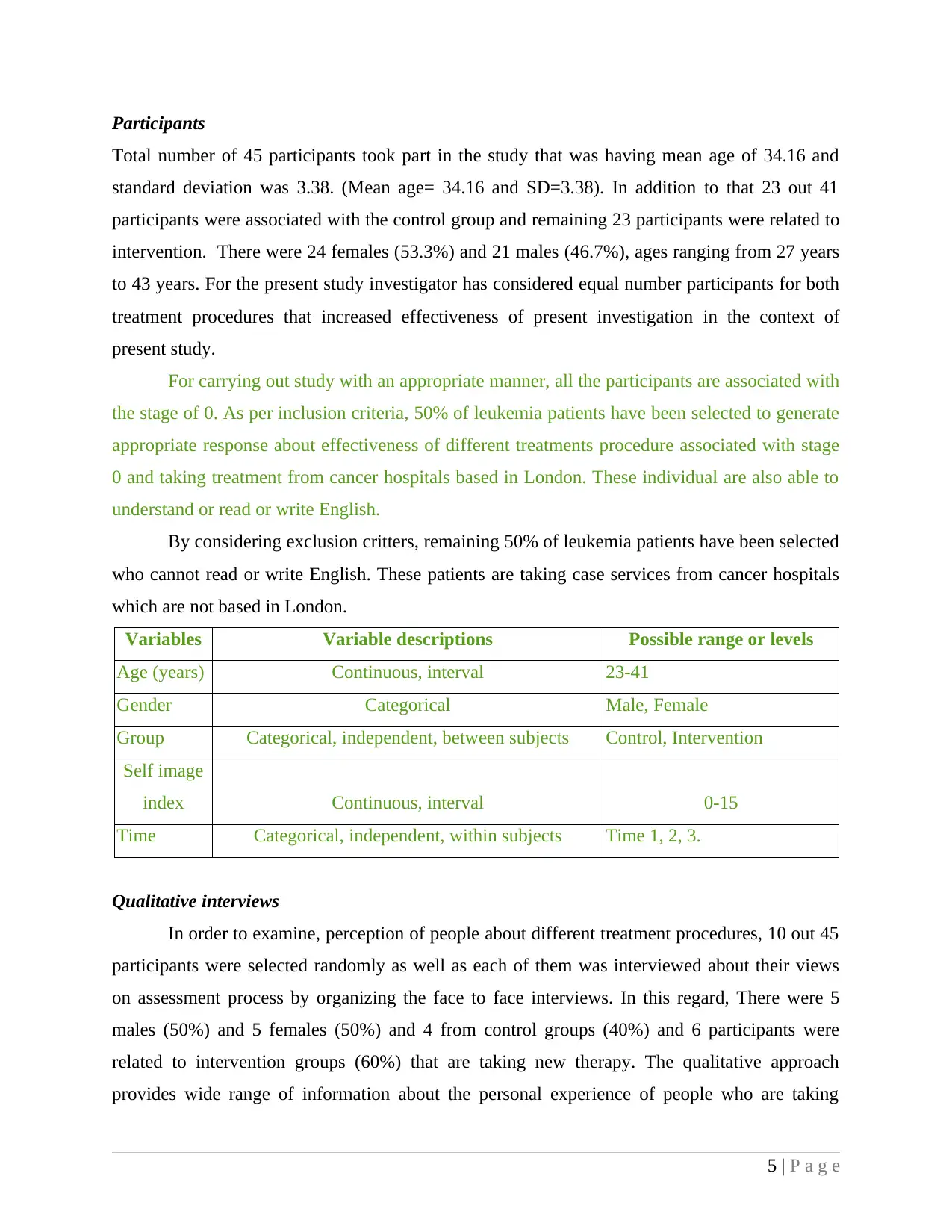
Participants
Total number of 45 participants took part in the study that was having mean age of 34.16 and
standard deviation was 3.38. (Mean age= 34.16 and SD=3.38). In addition to that 23 out 41
participants were associated with the control group and remaining 23 participants were related to
intervention. There were 24 females (53.3%) and 21 males (46.7%), ages ranging from 27 years
to 43 years. For the present study investigator has considered equal number participants for both
treatment procedures that increased effectiveness of present investigation in the context of
present study.
For carrying out study with an appropriate manner, all the participants are associated with
the stage of 0. As per inclusion criteria, 50% of leukemia patients have been selected to generate
appropriate response about effectiveness of different treatments procedure associated with stage
0 and taking treatment from cancer hospitals based in London. These individual are also able to
understand or read or write English.
By considering exclusion critters, remaining 50% of leukemia patients have been selected
who cannot read or write English. These patients are taking case services from cancer hospitals
which are not based in London.
Variables Variable descriptions Possible range or levels
Age (years) Continuous, interval 23-41
Gender Categorical Male, Female
Group Categorical, independent, between subjects Control, Intervention
Self image
index Continuous, interval 0-15
Time Categorical, independent, within subjects Time 1, 2, 3.
Qualitative interviews
In order to examine, perception of people about different treatment procedures, 10 out 45
participants were selected randomly as well as each of them was interviewed about their views
on assessment process by organizing the face to face interviews. In this regard, There were 5
males (50%) and 5 females (50%) and 4 from control groups (40%) and 6 participants were
related to intervention groups (60%) that are taking new therapy. The qualitative approach
provides wide range of information about the personal experience of people who are taking
5 | P a g e
Total number of 45 participants took part in the study that was having mean age of 34.16 and
standard deviation was 3.38. (Mean age= 34.16 and SD=3.38). In addition to that 23 out 41
participants were associated with the control group and remaining 23 participants were related to
intervention. There were 24 females (53.3%) and 21 males (46.7%), ages ranging from 27 years
to 43 years. For the present study investigator has considered equal number participants for both
treatment procedures that increased effectiveness of present investigation in the context of
present study.
For carrying out study with an appropriate manner, all the participants are associated with
the stage of 0. As per inclusion criteria, 50% of leukemia patients have been selected to generate
appropriate response about effectiveness of different treatments procedure associated with stage
0 and taking treatment from cancer hospitals based in London. These individual are also able to
understand or read or write English.
By considering exclusion critters, remaining 50% of leukemia patients have been selected
who cannot read or write English. These patients are taking case services from cancer hospitals
which are not based in London.
Variables Variable descriptions Possible range or levels
Age (years) Continuous, interval 23-41
Gender Categorical Male, Female
Group Categorical, independent, between subjects Control, Intervention
Self image
index Continuous, interval 0-15
Time Categorical, independent, within subjects Time 1, 2, 3.
Qualitative interviews
In order to examine, perception of people about different treatment procedures, 10 out 45
participants were selected randomly as well as each of them was interviewed about their views
on assessment process by organizing the face to face interviews. In this regard, There were 5
males (50%) and 5 females (50%) and 4 from control groups (40%) and 6 participants were
related to intervention groups (60%) that are taking new therapy. The qualitative approach
provides wide range of information about the personal experience of people who are taking
5 | P a g e
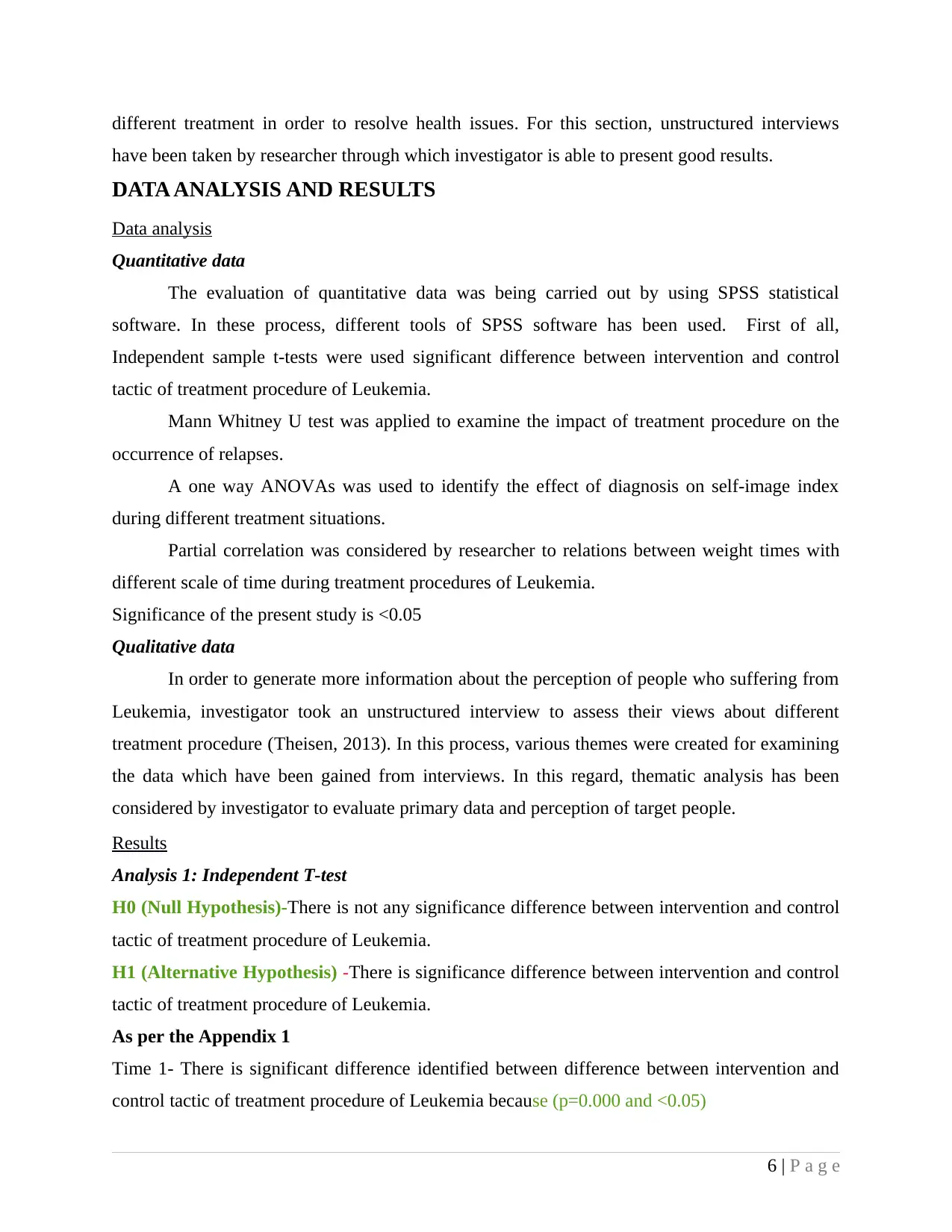
different treatment in order to resolve health issues. For this section, unstructured interviews
have been taken by researcher through which investigator is able to present good results.
DATA ANALYSIS AND RESULTS
Data analysis
Quantitative data
The evaluation of quantitative data was being carried out by using SPSS statistical
software. In these process, different tools of SPSS software has been used. First of all,
Independent sample t-tests were used significant difference between intervention and control
tactic of treatment procedure of Leukemia.
Mann Whitney U test was applied to examine the impact of treatment procedure on the
occurrence of relapses.
A one way ANOVAs was used to identify the effect of diagnosis on self-image index
during different treatment situations.
Partial correlation was considered by researcher to relations between weight times with
different scale of time during treatment procedures of Leukemia.
Significance of the present study is <0.05
Qualitative data
In order to generate more information about the perception of people who suffering from
Leukemia, investigator took an unstructured interview to assess their views about different
treatment procedure (Theisen, 2013). In this process, various themes were created for examining
the data which have been gained from interviews. In this regard, thematic analysis has been
considered by investigator to evaluate primary data and perception of target people.
Results
Analysis 1: Independent T-test
H0 (Null Hypothesis)-There is not any significance difference between intervention and control
tactic of treatment procedure of Leukemia.
H1 (Alternative Hypothesis) -There is significance difference between intervention and control
tactic of treatment procedure of Leukemia.
As per the Appendix 1
Time 1- There is significant difference identified between difference between intervention and
control tactic of treatment procedure of Leukemia because (p=0.000 and <0.05)
6 | P a g e
have been taken by researcher through which investigator is able to present good results.
DATA ANALYSIS AND RESULTS
Data analysis
Quantitative data
The evaluation of quantitative data was being carried out by using SPSS statistical
software. In these process, different tools of SPSS software has been used. First of all,
Independent sample t-tests were used significant difference between intervention and control
tactic of treatment procedure of Leukemia.
Mann Whitney U test was applied to examine the impact of treatment procedure on the
occurrence of relapses.
A one way ANOVAs was used to identify the effect of diagnosis on self-image index
during different treatment situations.
Partial correlation was considered by researcher to relations between weight times with
different scale of time during treatment procedures of Leukemia.
Significance of the present study is <0.05
Qualitative data
In order to generate more information about the perception of people who suffering from
Leukemia, investigator took an unstructured interview to assess their views about different
treatment procedure (Theisen, 2013). In this process, various themes were created for examining
the data which have been gained from interviews. In this regard, thematic analysis has been
considered by investigator to evaluate primary data and perception of target people.
Results
Analysis 1: Independent T-test
H0 (Null Hypothesis)-There is not any significance difference between intervention and control
tactic of treatment procedure of Leukemia.
H1 (Alternative Hypothesis) -There is significance difference between intervention and control
tactic of treatment procedure of Leukemia.
As per the Appendix 1
Time 1- There is significant difference identified between difference between intervention and
control tactic of treatment procedure of Leukemia because (p=0.000 and <0.05)
6 | P a g e
⊘ This is a preview!⊘
Do you want full access?
Subscribe today to unlock all pages.

Trusted by 1+ million students worldwide
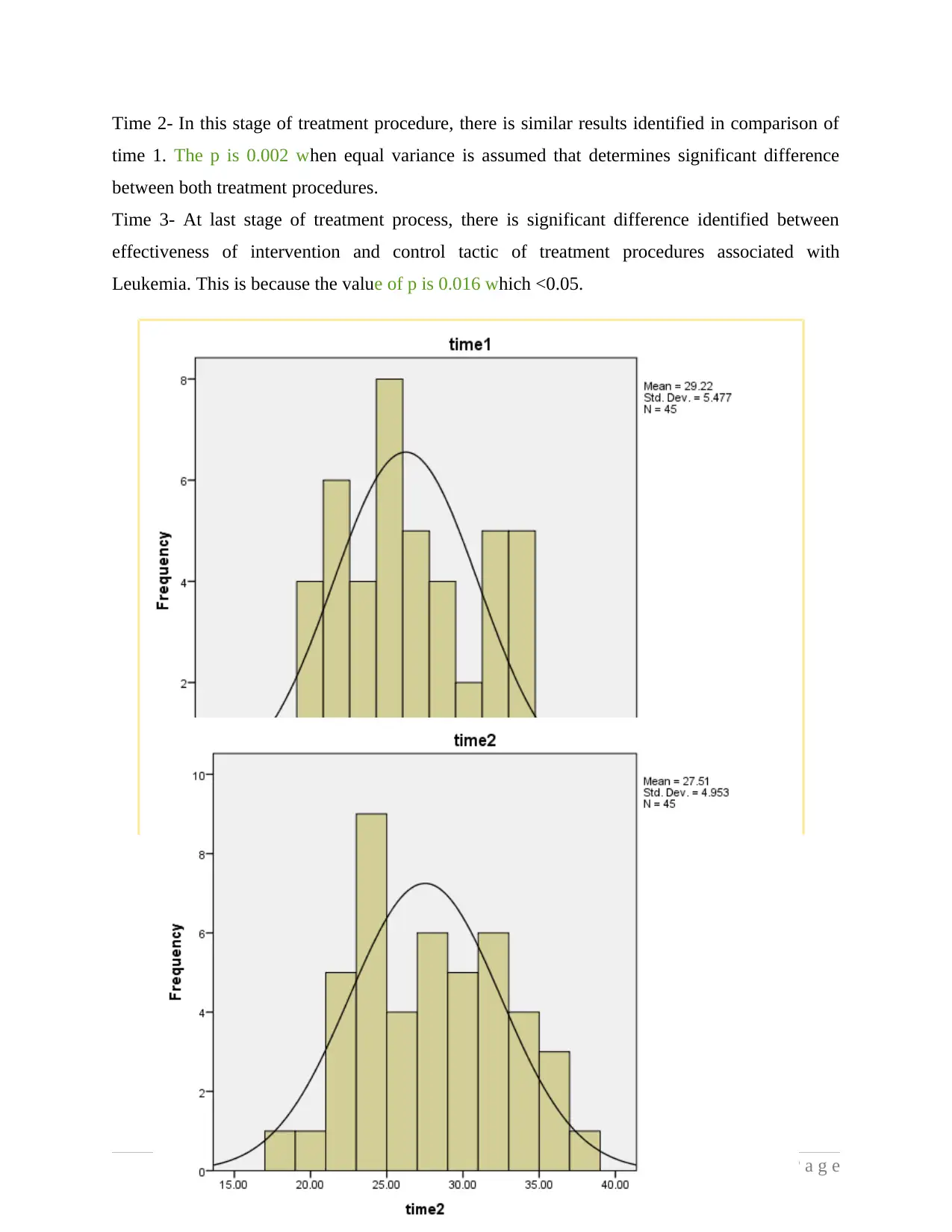
Time 2- In this stage of treatment procedure, there is similar results identified in comparison of
time 1. The p is 0.002 when equal variance is assumed that determines significant difference
between both treatment procedures.
Time 3- At last stage of treatment process, there is significant difference identified between
effectiveness of intervention and control tactic of treatment procedures associated with
Leukemia. This is because the value of p is 0.016 which <0.05.
7 | P a g e
time 1. The p is 0.002 when equal variance is assumed that determines significant difference
between both treatment procedures.
Time 3- At last stage of treatment process, there is significant difference identified between
effectiveness of intervention and control tactic of treatment procedures associated with
Leukemia. This is because the value of p is 0.016 which <0.05.
7 | P a g e
Paraphrase This Document
Need a fresh take? Get an instant paraphrase of this document with our AI Paraphraser
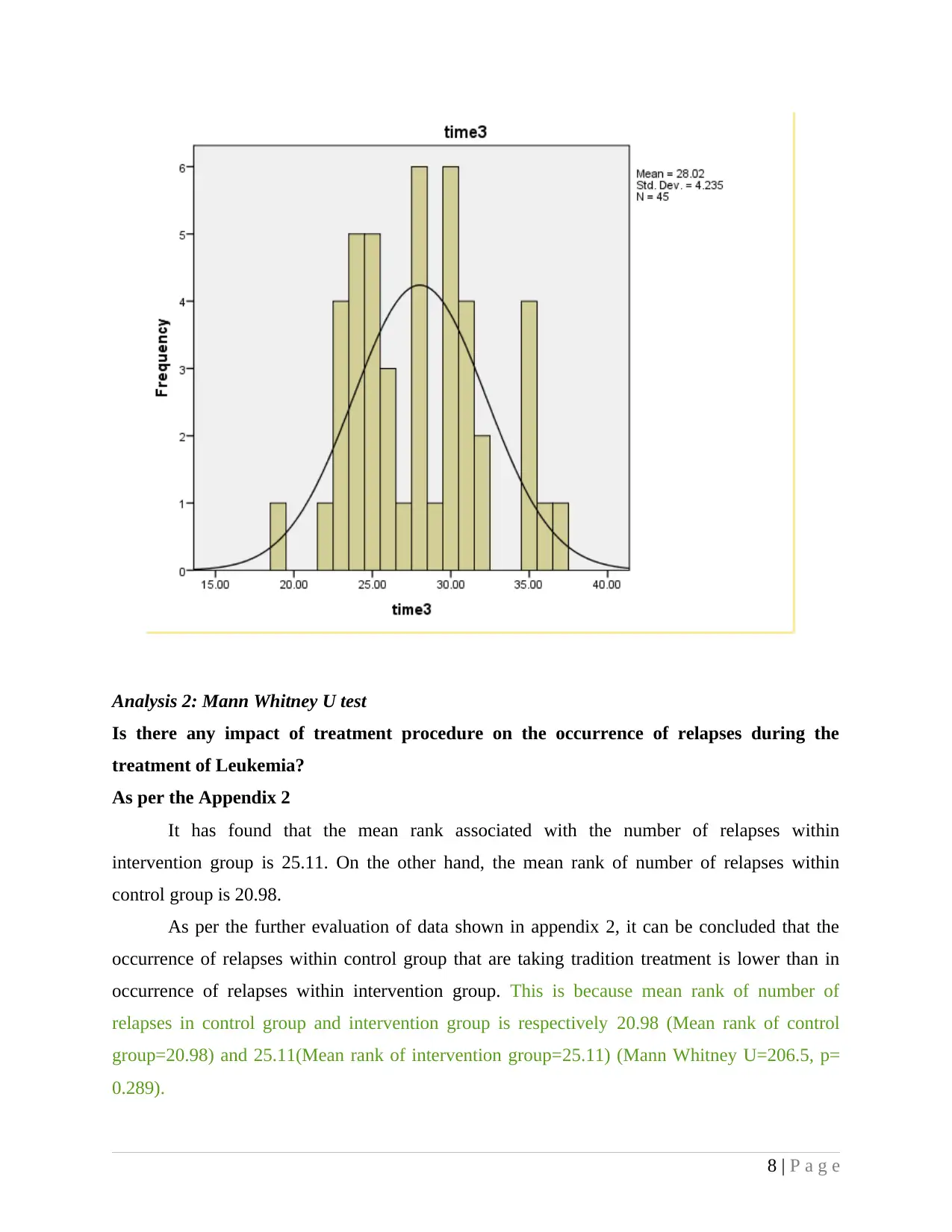
Analysis 2: Mann Whitney U test
Is there any impact of treatment procedure on the occurrence of relapses during the
treatment of Leukemia?
As per the Appendix 2
It has found that the mean rank associated with the number of relapses within
intervention group is 25.11. On the other hand, the mean rank of number of relapses within
control group is 20.98.
As per the further evaluation of data shown in appendix 2, it can be concluded that the
occurrence of relapses within control group that are taking tradition treatment is lower than in
occurrence of relapses within intervention group. This is because mean rank of number of
relapses in control group and intervention group is respectively 20.98 (Mean rank of control
group=20.98) and 25.11(Mean rank of intervention group=25.11) (Mann Whitney U=206.5, p=
0.289).
8 | P a g e
Is there any impact of treatment procedure on the occurrence of relapses during the
treatment of Leukemia?
As per the Appendix 2
It has found that the mean rank associated with the number of relapses within
intervention group is 25.11. On the other hand, the mean rank of number of relapses within
control group is 20.98.
As per the further evaluation of data shown in appendix 2, it can be concluded that the
occurrence of relapses within control group that are taking tradition treatment is lower than in
occurrence of relapses within intervention group. This is because mean rank of number of
relapses in control group and intervention group is respectively 20.98 (Mean rank of control
group=20.98) and 25.11(Mean rank of intervention group=25.11) (Mann Whitney U=206.5, p=
0.289).
8 | P a g e
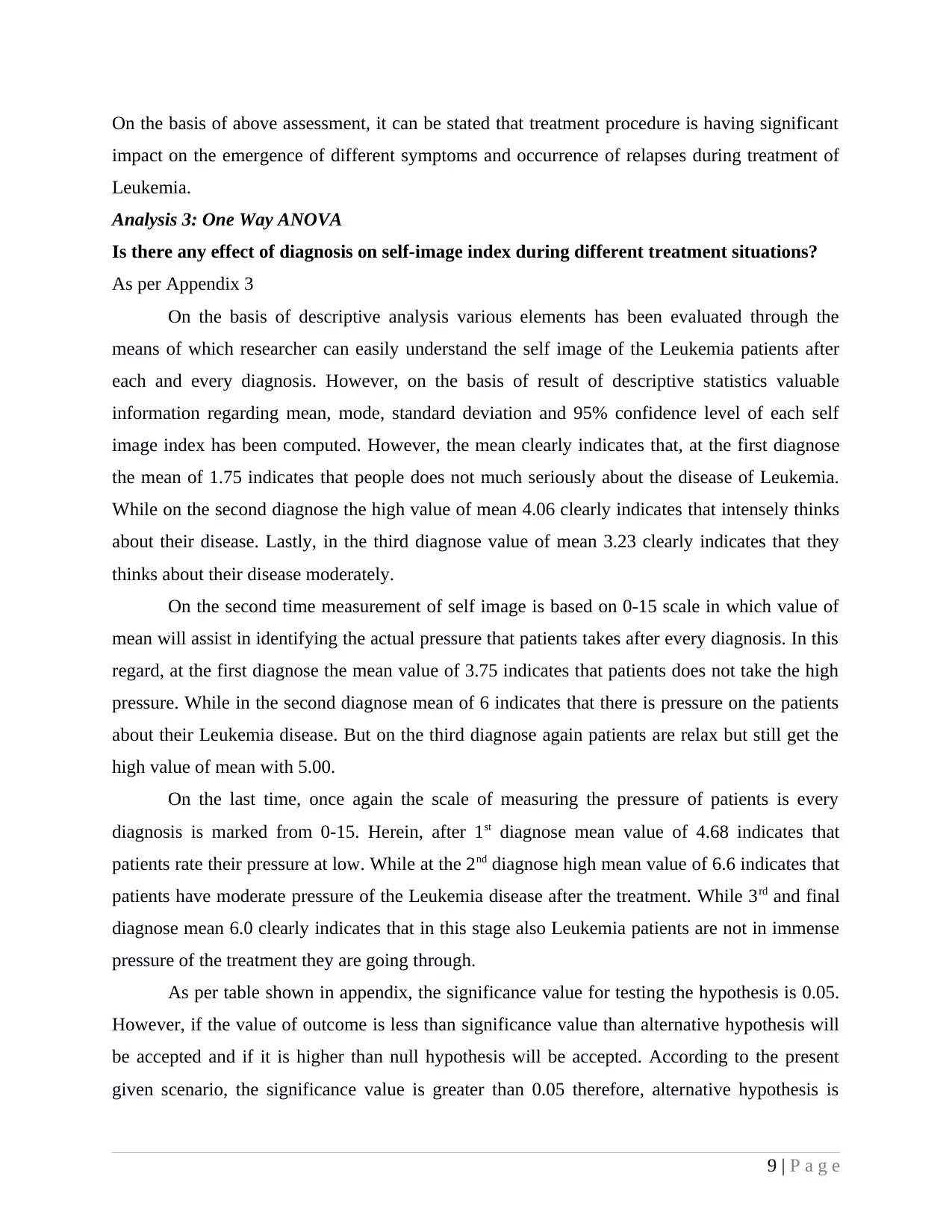
On the basis of above assessment, it can be stated that treatment procedure is having significant
impact on the emergence of different symptoms and occurrence of relapses during treatment of
Leukemia.
Analysis 3: One Way ANOVA
Is there any effect of diagnosis on self-image index during different treatment situations?
As per Appendix 3
On the basis of descriptive analysis various elements has been evaluated through the
means of which researcher can easily understand the self image of the Leukemia patients after
each and every diagnosis. However, on the basis of result of descriptive statistics valuable
information regarding mean, mode, standard deviation and 95% confidence level of each self
image index has been computed. However, the mean clearly indicates that, at the first diagnose
the mean of 1.75 indicates that people does not much seriously about the disease of Leukemia.
While on the second diagnose the high value of mean 4.06 clearly indicates that intensely thinks
about their disease. Lastly, in the third diagnose value of mean 3.23 clearly indicates that they
thinks about their disease moderately.
On the second time measurement of self image is based on 0-15 scale in which value of
mean will assist in identifying the actual pressure that patients takes after every diagnosis. In this
regard, at the first diagnose the mean value of 3.75 indicates that patients does not take the high
pressure. While in the second diagnose mean of 6 indicates that there is pressure on the patients
about their Leukemia disease. But on the third diagnose again patients are relax but still get the
high value of mean with 5.00.
On the last time, once again the scale of measuring the pressure of patients is every
diagnosis is marked from 0-15. Herein, after 1st diagnose mean value of 4.68 indicates that
patients rate their pressure at low. While at the 2nd diagnose high mean value of 6.6 indicates that
patients have moderate pressure of the Leukemia disease after the treatment. While 3rd and final
diagnose mean 6.0 clearly indicates that in this stage also Leukemia patients are not in immense
pressure of the treatment they are going through.
As per table shown in appendix, the significance value for testing the hypothesis is 0.05.
However, if the value of outcome is less than significance value than alternative hypothesis will
be accepted and if it is higher than null hypothesis will be accepted. According to the present
given scenario, the significance value is greater than 0.05 therefore, alternative hypothesis is
9 | P a g e
impact on the emergence of different symptoms and occurrence of relapses during treatment of
Leukemia.
Analysis 3: One Way ANOVA
Is there any effect of diagnosis on self-image index during different treatment situations?
As per Appendix 3
On the basis of descriptive analysis various elements has been evaluated through the
means of which researcher can easily understand the self image of the Leukemia patients after
each and every diagnosis. However, on the basis of result of descriptive statistics valuable
information regarding mean, mode, standard deviation and 95% confidence level of each self
image index has been computed. However, the mean clearly indicates that, at the first diagnose
the mean of 1.75 indicates that people does not much seriously about the disease of Leukemia.
While on the second diagnose the high value of mean 4.06 clearly indicates that intensely thinks
about their disease. Lastly, in the third diagnose value of mean 3.23 clearly indicates that they
thinks about their disease moderately.
On the second time measurement of self image is based on 0-15 scale in which value of
mean will assist in identifying the actual pressure that patients takes after every diagnosis. In this
regard, at the first diagnose the mean value of 3.75 indicates that patients does not take the high
pressure. While in the second diagnose mean of 6 indicates that there is pressure on the patients
about their Leukemia disease. But on the third diagnose again patients are relax but still get the
high value of mean with 5.00.
On the last time, once again the scale of measuring the pressure of patients is every
diagnosis is marked from 0-15. Herein, after 1st diagnose mean value of 4.68 indicates that
patients rate their pressure at low. While at the 2nd diagnose high mean value of 6.6 indicates that
patients have moderate pressure of the Leukemia disease after the treatment. While 3rd and final
diagnose mean 6.0 clearly indicates that in this stage also Leukemia patients are not in immense
pressure of the treatment they are going through.
As per table shown in appendix, the significance value for testing the hypothesis is 0.05.
However, if the value of outcome is less than significance value than alternative hypothesis will
be accepted and if it is higher than null hypothesis will be accepted. According to the present
given scenario, the significance value is greater than 0.05 therefore, alternative hypothesis is
9 | P a g e
⊘ This is a preview!⊘
Do you want full access?
Subscribe today to unlock all pages.

Trusted by 1+ million students worldwide
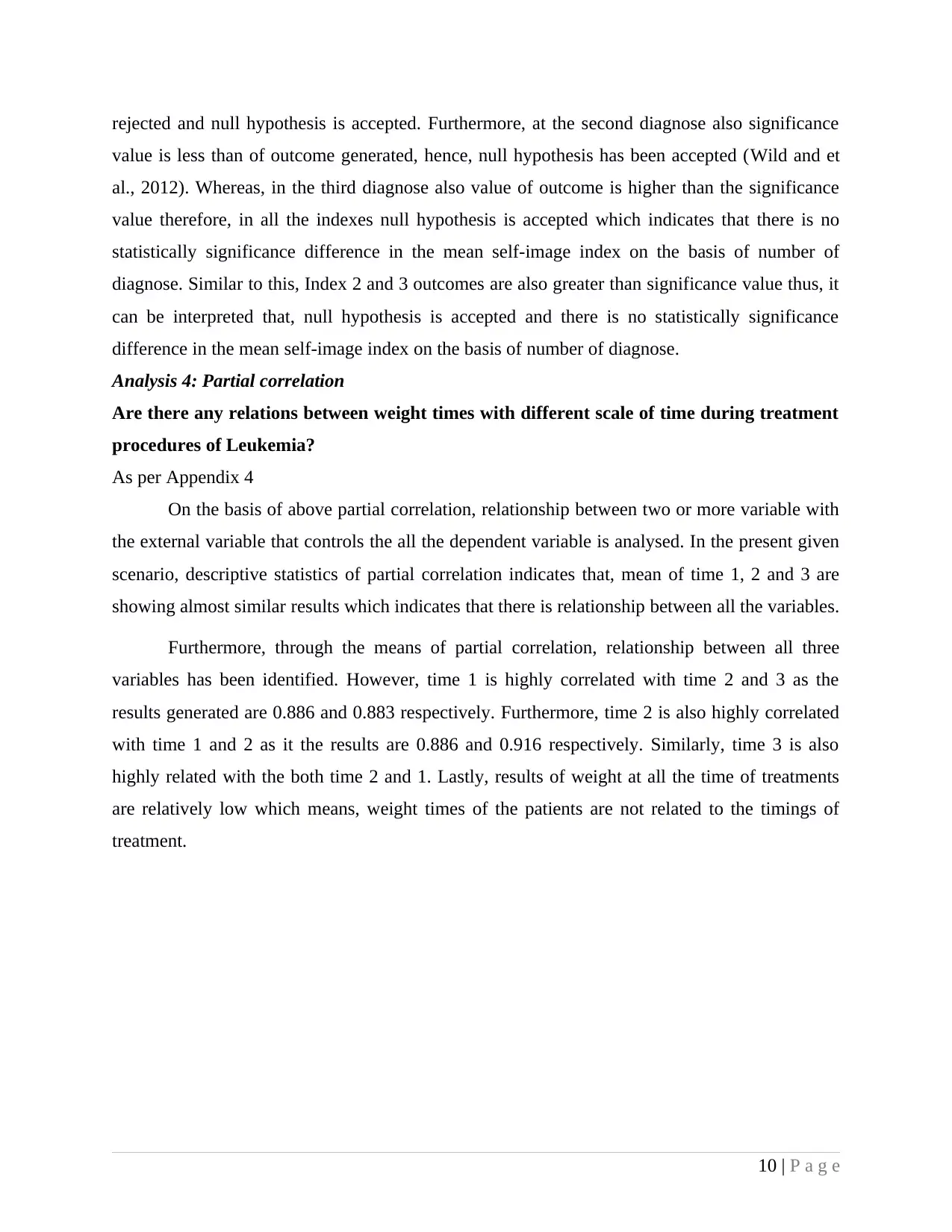
rejected and null hypothesis is accepted. Furthermore, at the second diagnose also significance
value is less than of outcome generated, hence, null hypothesis has been accepted (Wild and et
al., 2012). Whereas, in the third diagnose also value of outcome is higher than the significance
value therefore, in all the indexes null hypothesis is accepted which indicates that there is no
statistically significance difference in the mean self-image index on the basis of number of
diagnose. Similar to this, Index 2 and 3 outcomes are also greater than significance value thus, it
can be interpreted that, null hypothesis is accepted and there is no statistically significance
difference in the mean self-image index on the basis of number of diagnose.
Analysis 4: Partial correlation
Are there any relations between weight times with different scale of time during treatment
procedures of Leukemia?
As per Appendix 4
On the basis of above partial correlation, relationship between two or more variable with
the external variable that controls the all the dependent variable is analysed. In the present given
scenario, descriptive statistics of partial correlation indicates that, mean of time 1, 2 and 3 are
showing almost similar results which indicates that there is relationship between all the variables.
Furthermore, through the means of partial correlation, relationship between all three
variables has been identified. However, time 1 is highly correlated with time 2 and 3 as the
results generated are 0.886 and 0.883 respectively. Furthermore, time 2 is also highly correlated
with time 1 and 2 as it the results are 0.886 and 0.916 respectively. Similarly, time 3 is also
highly related with the both time 2 and 1. Lastly, results of weight at all the time of treatments
are relatively low which means, weight times of the patients are not related to the timings of
treatment.
10 | P a g e
value is less than of outcome generated, hence, null hypothesis has been accepted (Wild and et
al., 2012). Whereas, in the third diagnose also value of outcome is higher than the significance
value therefore, in all the indexes null hypothesis is accepted which indicates that there is no
statistically significance difference in the mean self-image index on the basis of number of
diagnose. Similar to this, Index 2 and 3 outcomes are also greater than significance value thus, it
can be interpreted that, null hypothesis is accepted and there is no statistically significance
difference in the mean self-image index on the basis of number of diagnose.
Analysis 4: Partial correlation
Are there any relations between weight times with different scale of time during treatment
procedures of Leukemia?
As per Appendix 4
On the basis of above partial correlation, relationship between two or more variable with
the external variable that controls the all the dependent variable is analysed. In the present given
scenario, descriptive statistics of partial correlation indicates that, mean of time 1, 2 and 3 are
showing almost similar results which indicates that there is relationship between all the variables.
Furthermore, through the means of partial correlation, relationship between all three
variables has been identified. However, time 1 is highly correlated with time 2 and 3 as the
results generated are 0.886 and 0.883 respectively. Furthermore, time 2 is also highly correlated
with time 1 and 2 as it the results are 0.886 and 0.916 respectively. Similarly, time 3 is also
highly related with the both time 2 and 1. Lastly, results of weight at all the time of treatments
are relatively low which means, weight times of the patients are not related to the timings of
treatment.
10 | P a g e
Paraphrase This Document
Need a fresh take? Get an instant paraphrase of this document with our AI Paraphraser
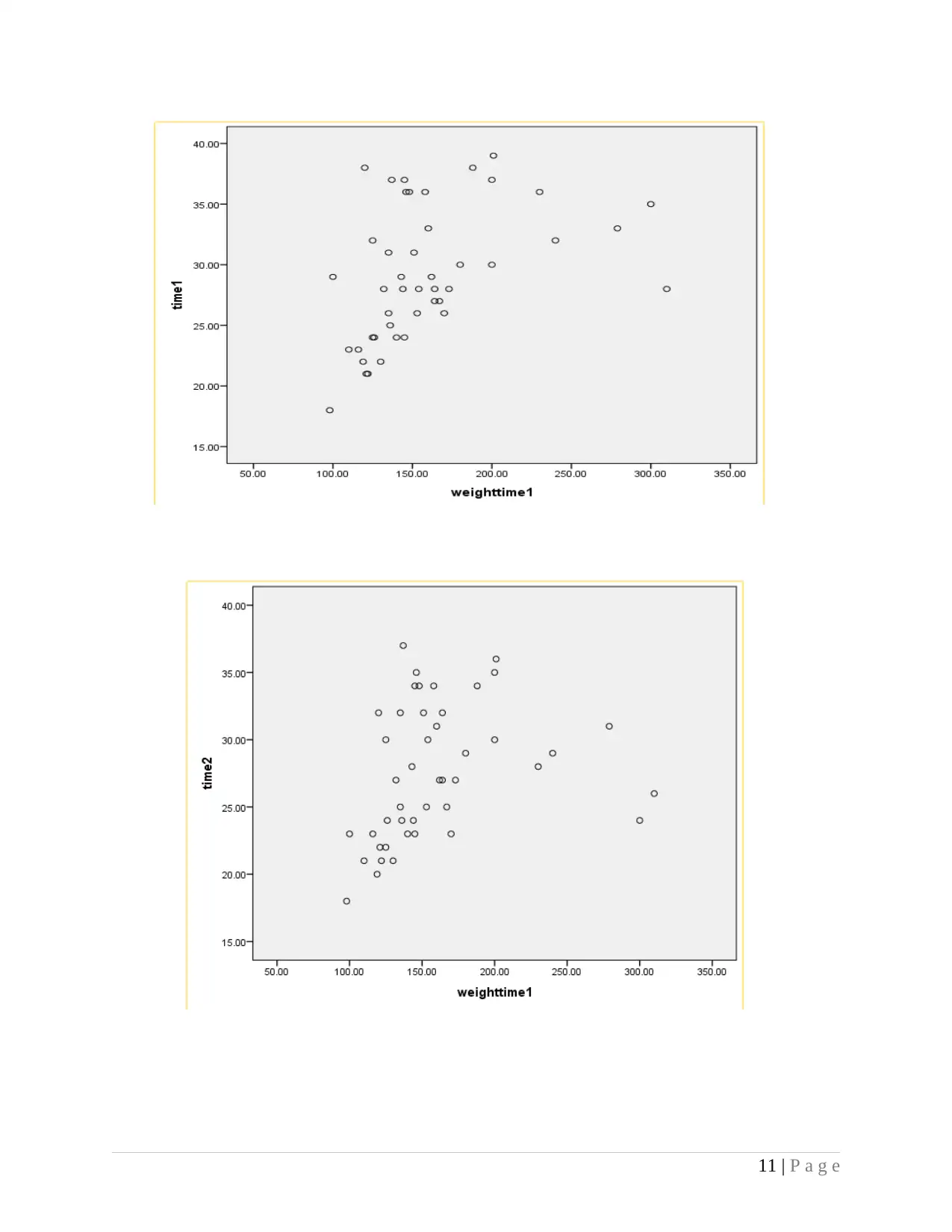
11 | P a g e
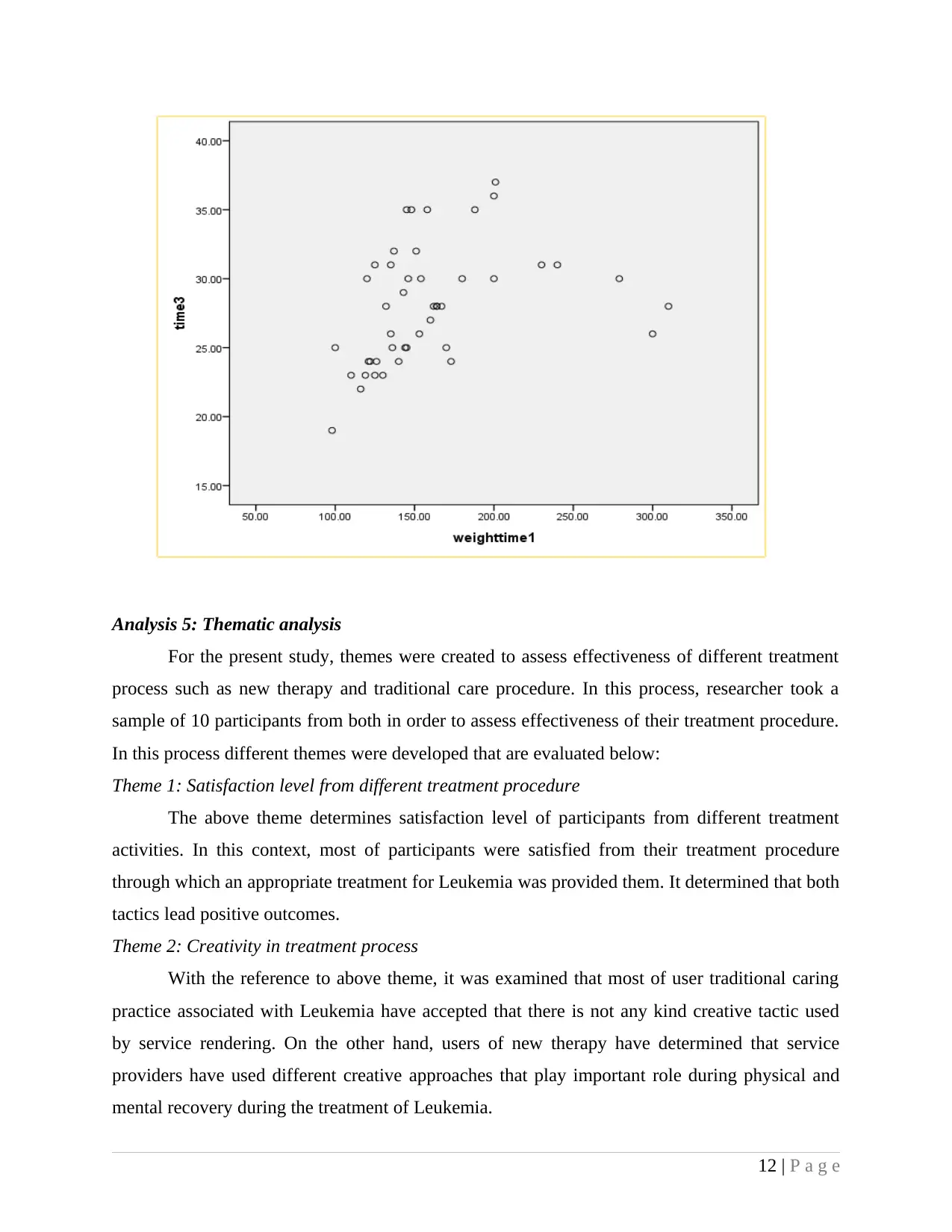
Analysis 5: Thematic analysis
For the present study, themes were created to assess effectiveness of different treatment
process such as new therapy and traditional care procedure. In this process, researcher took a
sample of 10 participants from both in order to assess effectiveness of their treatment procedure.
In this process different themes were developed that are evaluated below:
Theme 1: Satisfaction level from different treatment procedure
The above theme determines satisfaction level of participants from different treatment
activities. In this context, most of participants were satisfied from their treatment procedure
through which an appropriate treatment for Leukemia was provided them. It determined that both
tactics lead positive outcomes.
Theme 2: Creativity in treatment process
With the reference to above theme, it was examined that most of user traditional caring
practice associated with Leukemia have accepted that there is not any kind creative tactic used
by service rendering. On the other hand, users of new therapy have determined that service
providers have used different creative approaches that play important role during physical and
mental recovery during the treatment of Leukemia.
12 | P a g e
For the present study, themes were created to assess effectiveness of different treatment
process such as new therapy and traditional care procedure. In this process, researcher took a
sample of 10 participants from both in order to assess effectiveness of their treatment procedure.
In this process different themes were developed that are evaluated below:
Theme 1: Satisfaction level from different treatment procedure
The above theme determines satisfaction level of participants from different treatment
activities. In this context, most of participants were satisfied from their treatment procedure
through which an appropriate treatment for Leukemia was provided them. It determined that both
tactics lead positive outcomes.
Theme 2: Creativity in treatment process
With the reference to above theme, it was examined that most of user traditional caring
practice associated with Leukemia have accepted that there is not any kind creative tactic used
by service rendering. On the other hand, users of new therapy have determined that service
providers have used different creative approaches that play important role during physical and
mental recovery during the treatment of Leukemia.
12 | P a g e
⊘ This is a preview!⊘
Do you want full access?
Subscribe today to unlock all pages.

Trusted by 1+ million students worldwide
1 out of 21
Related Documents
Your All-in-One AI-Powered Toolkit for Academic Success.
+13062052269
info@desklib.com
Available 24*7 on WhatsApp / Email
![[object Object]](/_next/static/media/star-bottom.7253800d.svg)
Unlock your academic potential
Copyright © 2020–2025 A2Z Services. All Rights Reserved. Developed and managed by ZUCOL.





